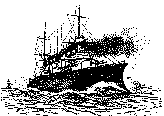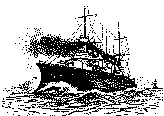World's Cheapest Foil Chart for NACA Section Profiles | ||||||||||||||||||||
| Monday, January 13, 1997 Version 1.5
Craig O'Donnell See my Proa FAQ Part 1 of my Much.Too.Much.Boat.Technology.For.My/Own/Good.FAQ
|
| This is a "freeze-dried" summary of everything I've managed to learn researching boats and foil shapes for rudders, leeboards, etc. As a result it glosses over a lot. That's OK. This is supposed to be just enough to let any Joe Average or Jane Typical, someone like me, confidently make decisions about whether or not to shape daggerboards, rudders, and such like an airfoil. I've deliberately left out bibiliographical references. If you're making a wingsail or a wingmast, the same coordinates apply, by the way. Since air is less dense than water you can use a very fat section profile (0018, 0025, 0030, maybe greater) on a wingsail or wingmast. Why Bother?
|
| The basic NACA section profiles are "symmetrical" so they are good for rudders, especially, but also leeboards, daggerboards and centerboards. These are called the "four-digit" series and are identified by the name "NACA 00XX". Look at your board end-on (in other words, a fish-eye view from underwater). The Y dimension is measured in both directions from an imaginary centerline through your board. It gives you both thickness and curvature. Connect the dots with a flexible batten (for example, 1/2-inch PVC tubing works for large foils. On small ones try piano wire, or if you have musician friends, a bass guitar G-string). The chord is the "width" or front-to-back dimension of your board(s). For example, on certain Bolger boats the rudder and leeboard are both 10 inches wide. That's the chord. The thickness of a NACA section depends entirely on the chord of your board. Finally, don't cheat. You'll discover that foil sections are thicker than you imagine. That's OK, because a proper foil shape has much less drag than you think looking at it. The thicker the foil, the more lift it will give you. The drag also increases as the foils get thicker, but you can't really separate drag and lift. Foils for boats seem to generally encompass 0010-0015 for centerboards and 0015-0025 for rudders. Symmetrical foils are by far the easiest to make by hand. If you have access to CAD-CAM machinery by all means go nuts. These coordinates were taken from a standard reference text [Riegels,
Aerofoil Sections]. He gives standard NACA profiles in this series as 0003,
0006, 0009, 0012, 0015, 0018, 0021, 0025, 0030. There is nothing magic
about this. An 0010 or 0017 profile is perfectly legitimate but you'll have
to generate the coordinates yourself. There is a formula but I'm not
talking Some Advice
|
|
| The main difference between a "thin flat plate" and a NACA foil is that the foil will generate lift, i.e. power, at a higher angle versus the boat's direction. Where a plain flat rudder will stall and simply slow you down somewhere around +/- 5 to 10 degrees from center, a NACA foil will be effective over maybe twice that range. Your boat's rudder will work better. Tacking will be easier. A little bit of weather helm translates into more sideways 'push' upwind. As a leeboard, centerboard or daggerboard the difference between the plate and foil would be much less pronounced because the boat is usually moving "crabwise" through the water at a much smaller angle than you'd use at the helm when tacking. As long as it doesn't vibrate, a flat plate is probably as effective and a lot less hassle than a shaped foil section. Using aluminum, brass (big in the 1880s and 1890s) or even iron eliminates having to weight a board to keep it down, and allows the plate to be very thin, which is good (3/32 to 1/8-inch, perhaps). Remember, the smaller your boat the more the drag of a flat plate affects you. (This is why skipjacks don't seem to care that their centerboards are about 4 inches thick and dead straight across the leading and trailing edges, and why keels on big sailing vessels are often flat at the stem and it doesn't matter that much. Loads of sail area = power). So thinner is better. So on a small boat keep the plate as thin as possible and as light as possible unless you need extra ballast weight. Aluminum, anyone? Example
|
|
| Let's say we have a 10-inch-wide (or 10-cm-wide) rudder to shape. How thick is the foil shape at the thickest? Remember, the thickness at each point depends on the chord of the board. |
| Section: | 0003 | 0006 | 0009 | 0012 | 0015 | 0018 | 0021 | 0025 | 0030 |
| in/cm: | 0.3 | 0.6 | 0.9 | 1.2 | 1.5 | 1.8 | 2.1 | 2.5 | 3.0 |
| Distance From Nose | NACA 0012 | NACA 0015 | NACA 0018 | NACA 0021 | NACA 0025 | NACA 0030 |
|---|---|---|---|---|---|---|
| 1.25 | 1.89 | 2.37 | 2.84 | 3.31 | 3.95 | see note 2 |
| 2.50 | 2.62 | 3.27 | 3.92 | 4.58 | 5.45 | ---- |
| 5.00 | 3.56 | 4.44 | 5.33 | 6.22 | 7.41 | ---- |
| 7.50 | 4.20 | 5.25 | 6.30 | 7.35 | 8.75 | ---- |
| 10.00 | 4.68 | 5.85 | 7.02 | 8.20 | 9.76 | ---- |
| 15.00 | 5.34 | 6.68 | 8.02 | 9.35 | 11.14 | ---- |
| 20.00 | 5.74 | 7.17 | 8.61 | 10.04 | 11.95 | ---- |
| 30.00 | 6.00 | 7.50 | 9.00 | 10.50 | 12.50 | see note 5 |
| 40.00 | 5.80 | 7.25 | 8.70 | 10.16 | 12.09 | ---- |
| 50.00 | 5.29 | 6.62 | 7.94 | 9.26 | 11.03 | ---- |
| 60.00 | 4.56 | 5.70 | 6.84 | 7.99 | 9.51 | ---- |
| 70.00 | 3.66 | 4.58 | 5.50 | 6.41 | 7.63 | ---- |
| 80.00 | 2.62 | 3.28 | 3.94 | 4.59 | 5.46 | ---- |
| 90.00 | 1.45 | 1.81 | 2.17 | 2.53 | 3.02 | ---- |
| 95.00 | 0.81 | 1.01 | 1.21 | 1.41 | 1.68 | ---- |
| 100.00 | 0.13 | 0.16 | 0.19 | 0.22 | 0.26 | ---- |
| All Measurements in Percent of Chord | ||||||
Further Silliness?
|
|
This is not the last word on foils by any means but I hope to save YOU the
time, energy and frustration involved in finding out The Real Foil Story
Without Studying Fluid Dynamics Full Time.
| I'd rather be sailing. Macintosh users should find Foils 1.2 for a freeware foil-drawing application. PC users can find NACAGEN, a shareware program for doing the same thing. |
 Back to John's Nautical Page
Back to John's Nautical Page

|
